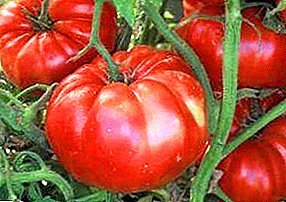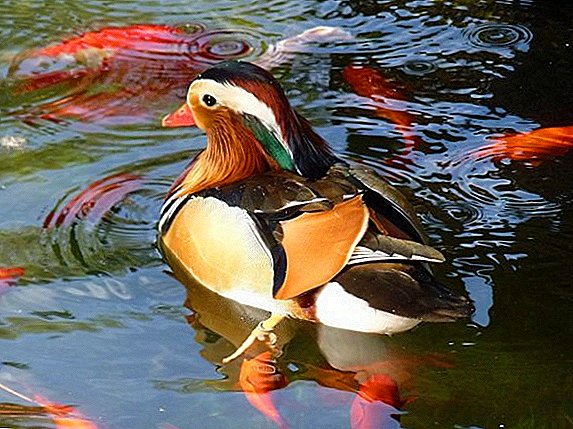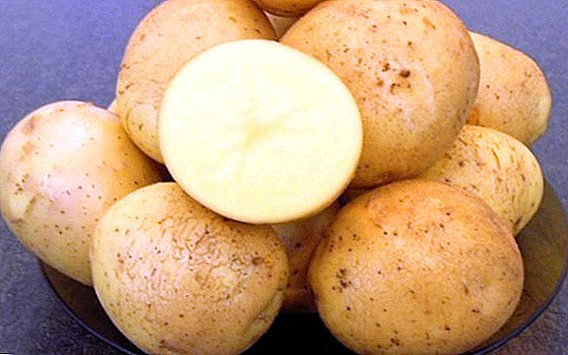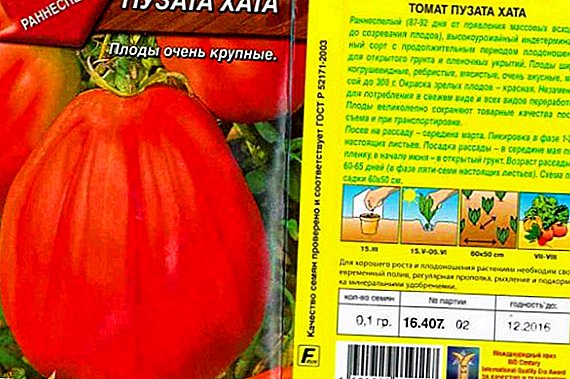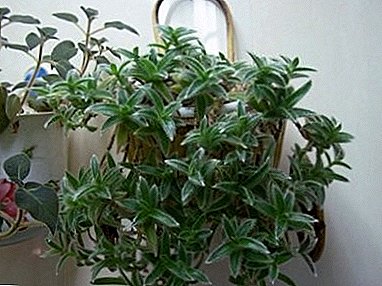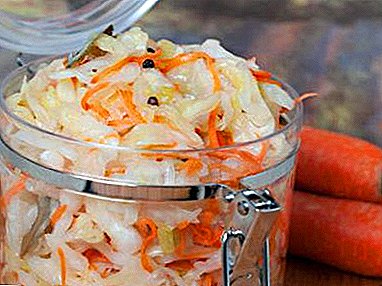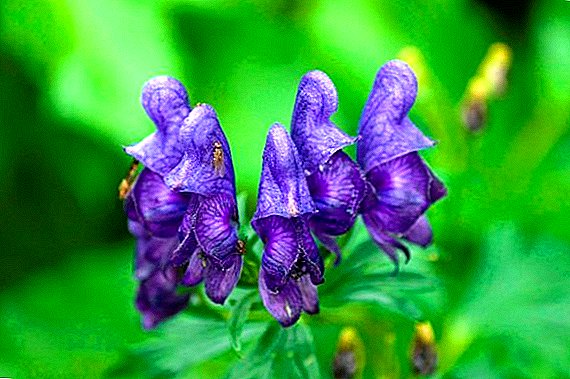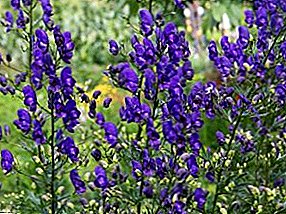 Aconite - herbaceous perennial plant of the genus buttercups, with straight stems. He has an unusual form of flowers, often blue shades, there are white and yellow. Aconite blooms in July, its inflorescences resemble lupine flowers. Almost all types of aconite are poisonous.
Aconite - herbaceous perennial plant of the genus buttercups, with straight stems. He has an unusual form of flowers, often blue shades, there are white and yellow. Aconite blooms in July, its inflorescences resemble lupine flowers. Almost all types of aconite are poisonous.
Aconite high (Aconite exelsum)
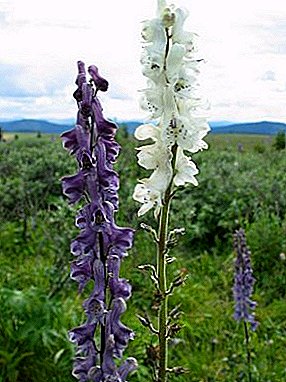 Aconite high in the natural environment is common in the forests of Russia, in the south of Siberia and in the mountainous areas of Central Asia. This species grows up to two meters, it has strong thickened stems with grooves. Stems are straight, pubescent with a long nap. Large leaves are divided into several parts of a diamond shape. Aconite blooms high or wrestler high, as it is called by the people, at the end of June - July.
Aconite high in the natural environment is common in the forests of Russia, in the south of Siberia and in the mountainous areas of Central Asia. This species grows up to two meters, it has strong thickened stems with grooves. Stems are straight, pubescent with a long nap. Large leaves are divided into several parts of a diamond shape. Aconite blooms high or wrestler high, as it is called by the people, at the end of June - July.
Racemes inflorescences with purple-gray flowers, inflorescence up to half a meter. This plant is a mesophyte, is not afraid of shade, prefers moderately moist and nutritious soil. Both alkaloids are present in the roots and in the aboveground part.
Did you know? Aconite for a long time in ancient medicine used for medicinal purposes. Roman scientist Pliny the Elder wrote in his writings that aconite is natural arsenic, its properties should be used carefully, otherwise the plant will be killed instead of treatment.
Aconite Wolf (Aconitum lycoctonum)
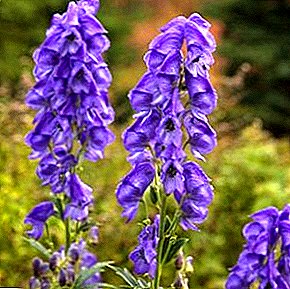 In nature, wolf aconite grows in the south of Siberia, in the European part of Russia and in the countries of Western Europe. This is a perennial with a powerful root system. Aconite wolf grows in the form of a pyramid or column, the height of the plant reaches 70 cm. The leaf plates are dissected, planted on long petioles. Aconite blooms in July - early August, bloom lasts more than a month. White or yellowish flowers are collected in clusters in the form of a brush. The plant has been cultivated since 1590.
In nature, wolf aconite grows in the south of Siberia, in the European part of Russia and in the countries of Western Europe. This is a perennial with a powerful root system. Aconite wolf grows in the form of a pyramid or column, the height of the plant reaches 70 cm. The leaf plates are dissected, planted on long petioles. Aconite blooms in July - early August, bloom lasts more than a month. White or yellowish flowers are collected in clusters in the form of a brush. The plant has been cultivated since 1590.
Why is this plant called the wolf, what is a wolf aconite? Perhaps the name is due to the fact that the grass was used to bait wolves. In the hungry periods, animals, falling into large flocks, brought a lot of harm to people. Perhaps due to the high toxicity of the plant: the alkaloids in the composition of aconite, acting on the nervous system, can cause suffocation, paralyzing the center of the respiratory system.
Aconite climbing (Aconitum volubile)
 Aconite winding love flower growers for a decorative look. In the wild, it is common in East Asia, Korea and Siberia. High, up to two meters, the plant has flexible and strong branches. Curling aconite has carved, glossy leaves of a dark green shade. In length, the stems reach four meters. Aconite blooms in early August and blooms for 50 days. The inflorescences are long and large, up to a meter in length. In aconite climbing flowers large dark blue.
Aconite winding love flower growers for a decorative look. In the wild, it is common in East Asia, Korea and Siberia. High, up to two meters, the plant has flexible and strong branches. Curling aconite has carved, glossy leaves of a dark green shade. In length, the stems reach four meters. Aconite blooms in early August and blooms for 50 days. The inflorescences are long and large, up to a meter in length. In aconite climbing flowers large dark blue.
Important! First aid for aconite poisoning is washing the stomach with salt water or a solution of potassium permanganate, activated carbon (1 tablet per ten kg of patient weight). These actions are only preliminary, so you need to call an ambulance to conduct a qualified treatment for poisoning.
Aconite arcuate (Aconitum arcuatum)
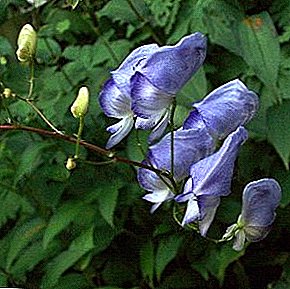
Aconite arcuate tolerates shade, decorative and non-toxic. In nature, it grows in the Far East. The plant is herbaceous, resistant to frost and unpretentious in cultivation and care. Aconite arcuate grows on any soil, is immune to disease.
Interesting! The origin of aconite is controversial: ancient Greek legends say that aconite grew out of a drop of Cerberus poisonous saliva, and Scandinavians believe that aconite grew out of drops of blood of Thor, who died in a battle with a poisonous snake.
Aconite cloak (Aconitum napellus)
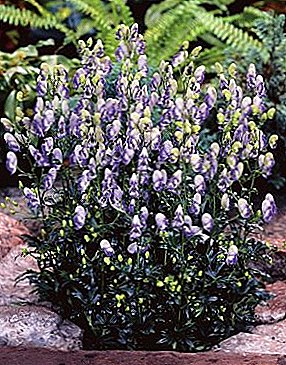 This species is common in all European countries, used for decorative purposes. Aconite klobuchkovy - perennial, plant height reaches one and a half meters. This aconite is poisonous. The plant reproduces by tubers, when a new tuber grows, the old one dies. Shoots straight with separated leaf plates.
This species is common in all European countries, used for decorative purposes. Aconite klobuchkovy - perennial, plant height reaches one and a half meters. This aconite is poisonous. The plant reproduces by tubers, when a new tuber grows, the old one dies. Shoots straight with separated leaf plates.
Its name aconite received because of the shape of the flower, similar to the hood (the headdress of a monk). The inflorescences are tall, topped with dark blue flowers. Bloom aconite bloom throughout the summer. Forms fruits with many seeds. Popular varieties: "Newrv Blue" with dark blue flowers and "Carneum" - pinkish-beige flowers. Both varieties are long cut.
Aconite motley (Aconitum variegatum)
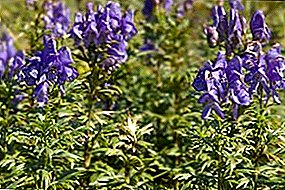 This species grows in the European part of Russia and in Europe. Perennial breeding tubers. The plant is tall, up to one and a half meters, with straight strong stalks. The sheet plate aconite variegated into seven parts. Leaves dense saturated green color. The inflorescences are long, loose, clustered in a brush. Blossoming aconite variegated from July for a month, flowers of blue shade. The plant has been used in plantings since 1584.
This species grows in the European part of Russia and in Europe. Perennial breeding tubers. The plant is tall, up to one and a half meters, with straight strong stalks. The sheet plate aconite variegated into seven parts. Leaves dense saturated green color. The inflorescences are long, loose, clustered in a brush. Blossoming aconite variegated from July for a month, flowers of blue shade. The plant has been used in plantings since 1584.
Aconite antidote (Aconitum anthora)
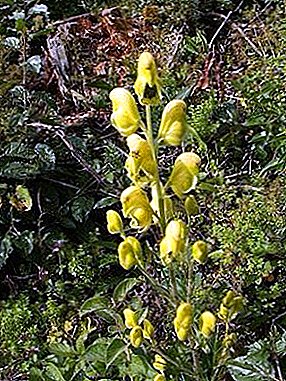 In nature, antidote aconite is found in Mongolia and Siberia. The plant loves lighted places, steppes and slopes. Aconite has straight, stems that are up to a meter high, at the bottom of which the leaves die. The stem is covered with a rare nap closer to the inflorescence. The leaves are large and long, up to seven centimeters, grow on long petioles. This aconite is an annual plant, after flowering the bush dies, multiplies by tubers or seeds. On long fluffy inflorescences bloom yellow flowers. Aconite antidote blooms in late July - early August.
In nature, antidote aconite is found in Mongolia and Siberia. The plant loves lighted places, steppes and slopes. Aconite has straight, stems that are up to a meter high, at the bottom of which the leaves die. The stem is covered with a rare nap closer to the inflorescence. The leaves are large and long, up to seven centimeters, grow on long petioles. This aconite is an annual plant, after flowering the bush dies, multiplies by tubers or seeds. On long fluffy inflorescences bloom yellow flowers. Aconite antidote blooms in late July - early August.
Attention! This species is characterized by slow growth, its development requires nutritious and moist loose soil.
North Aconite (Aconitum septentrionale)
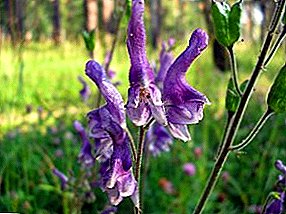 Aconite north reaches a height of one and a half meters, its homeland is considered the south of Siberia and the highlands of Central Asia. The plant has a flexible, thin stalk, straight and branched, pubescent in the upper part. The leaves reach a length of 30 cm, palmate, dissected into five to seven parts. Aconite flowers are colored from blue to bright purple. Blooms in July, after flowering forms leaflets with seeds. The root system is interesting, in contrast to other species in aconite of the northern one root rod. North Aconite breeds seeds.
Aconite north reaches a height of one and a half meters, its homeland is considered the south of Siberia and the highlands of Central Asia. The plant has a flexible, thin stalk, straight and branched, pubescent in the upper part. The leaves reach a length of 30 cm, palmate, dissected into five to seven parts. Aconite flowers are colored from blue to bright purple. Blooms in July, after flowering forms leaflets with seeds. The root system is interesting, in contrast to other species in aconite of the northern one root rod. North Aconite breeds seeds.
Aconite Fisher (Aconitum fischeri)
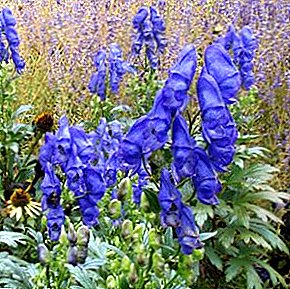 The homeland of aconite Fisher - the Far East. Grassy appearance, grows more than one and a half meters. Distributed in mixed and deciduous forest belts. The stems are straight, branched, the leaves are dense, coagulant, the plates are divided into several parts. This species blooms for a long time - from June to September. The flowers are bright blue, inflorescences can be lush and vice versa, depending on the habitat.
The homeland of aconite Fisher - the Far East. Grassy appearance, grows more than one and a half meters. Distributed in mixed and deciduous forest belts. The stems are straight, branched, the leaves are dense, coagulant, the plates are divided into several parts. This species blooms for a long time - from June to September. The flowers are bright blue, inflorescences can be lush and vice versa, depending on the habitat.
Aconite wool-resistant (Aconitum lasiostomum)
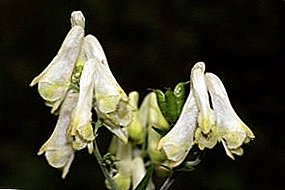 Aconite wool-resistant - a perennial look. Grows in central Russia, preferring forests of mixed forests. He has a straight stalk up to a meter in height. Bottom leaves have a weak edge, long petioles and leaf plates - up to ten centimeters, with a jagged edge. Racemes inflorescences up to 35 cm in length. Aconite blooms in July with yellow or pale yellow flowers. Pedicle of a plant covered with down. After flowering, leaflets ripen with seeds.
Aconite wool-resistant - a perennial look. Grows in central Russia, preferring forests of mixed forests. He has a straight stalk up to a meter in height. Bottom leaves have a weak edge, long petioles and leaf plates - up to ten centimeters, with a jagged edge. Racemes inflorescences up to 35 cm in length. Aconite blooms in July with yellow or pale yellow flowers. Pedicle of a plant covered with down. After flowering, leaflets ripen with seeds.
In the landscape design, you can use many varieties of aconite, they are all unpretentious and decorative. Aconites will perfectly frame the flower beds and be combined with more vivid flowers that have one large flower in the inflorescence; aconites moisture-loving near artificial reservoirs will look interesting, along the edge of the garden path as a border.


